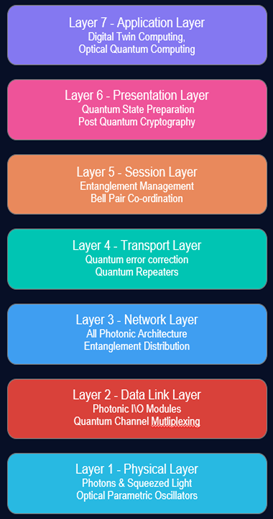Beyond the OSI Model: Architecting Quantum-Ready Networks

As quantum computing transitions from laboratory curiosity to commercial reality, network architects face an unprecedented challenge, designing networks capable of handling quantum information. The answer requires reimagining foundational networking principles while confronting formidable implementation hurdles.
The Foundation Under Pressure
For over forty years, the seven-layer OSI model has provided the backbone of network communication. This remarkably durable framework has adapted to countless technological advances whilst maintaining its essential architecture. Yet quantum networks operate under fundamentally different rules. Where classical networks freely copy and retransmit data, quantum systems must respect the no-cloning theorem, quantum information cannot be perfectly duplicated. Where classical security relies on computational complexity, quantum networks derive protection from physics itself.
The ISO has recognised this shift, publishing standards for Quantum Key Distribution (ISO/IEC 23837-1:2023) and Quantum Vocabulary (ISO/IEC 4879:2024). However, a comprehensive quantum networking framework remains absent, creating a critical gap.
A Quantum Architecture Emerges
The proposed Quantum OSI Model addresses this void by creating a parallel architecture mirroring classical networking's structure whilst embracing quantum mechanical principles. Each layer maintains familiar responsibilities but incorporates revolutionary technologies and significant challenges.

Layer 1 - Physical Layer
Photons replace electrons as primary information carriers. Optical Parametric Oscillators generate squeezed light states whilst single-photon sources enable quantum transmission. Current Reality: These sources struggle with efficiency issues and often require expensive cryogenic systems.
Layer 2 - Data Link Layer
This layer manages point-to-point quantum communication through photonic I/O modules and quantum channel multiplexing, enabling multiple quantum channels without destroying delicate quantum states. Challenge: Quantum states are extremely fragile, environmental noise can destroy information within microseconds.
Layer 3 - Network Layer
All-photonic architectures create end-to-end optical paths whilst quantum routing protocols distribute entanglement across networks. Scaling Barrier: Current systems are limited to point-to-point connections over hundreds of kilometres. Internet-scale quantum routing remains unsolved.
Layer 4 - Transport Layer
Quantum error correction and teleportation protocols ensure reliable state transfer. Quantum repeaters extend distances by refreshing states without destruction. Critical Limitation: Today's quantum memories maintain coherence for milliseconds, far short of practical requirements.
Layer 5 - Session Layer
Entanglement management coordinates Bell pairs and swapping operations across nodes. Synchronisation Challenge: Quantum operations require precise timing coordination, complex orchestration amplified by decoherence.
Layer 6 - Presentation Layer
Handles quantum state preparation through Continuous Variable systems whilst implementing Post-Quantum Cryptography. Standards Gap: Cryptographic standards are still evolving, with integration adding complexity.
Layer 7 - Application Layer
Digital twin computing and optical quantum platforms tackle problems impossible for classical systems, showcasing quantum networking's ultimate potential.
Two Paradigms, Profound Differences
Classical and quantum networking represent entirely different philosophies. Classical networks embrace redundancy; lost packets are simply retransmitted. Quantum networks cannot afford such luxury. Once measured or lost, quantum states cannot be perfectly recreated, forcing prevention-over-cure approaches. Security models differ equally dramatically. Classical protection builds on mathematical complexity assumptions. Quantum networks derive security from quantum mechanics: eavesdropping necessarily disturbs states, immediately revealing intrusion.
The Path Forward: Bridging Theory and Practice
The Quantum OSI Model embodies a paradigm shift towards networks harnessing quantum mechanics' intrinsic properties. However, moving from laboratory demonstrations to practical deployment faces substantial hurdles.
Current quantum networks operate under controlled conditions with limited scalability. Practical deployment requires breakthroughs in quantum error correction, room-temperature operation, and integration with existing infrastructure. Economics remain challenging, quantum hardware costs orders of magnitude more than classical equivalents.
Near-term reality suggests hybrid approaches: classical networks handling bulk transfer whilst quantum channels secure keys and enable specific computations. The quantum revolution will complement rather than replace existing infrastructure, creating networks leveraging both paradigms' strengths. As photonic systems, quantum repeaters, and continuous variable computing mature, we approach unprecedented security and computational capabilities. The future belongs to networks seamlessly integrating classical reliability with quantum capability, once we solve the formidable engineering challenges standing in our way. The Quantum OSI Model provides the conceptual framework. Now comes the harder task, making it work in practice.
